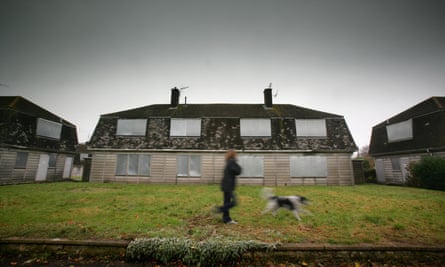How much domestic space do you need for a decent life? It’s a deeply political question – as political as how much money you need for a decent life – but we rarely see it as such. The distribution of living space in our crowded country, and how it changes over time, and why, is both too everyday an indicator of the balance of power between social groups for us to notice and such a fundamental one that we avoid thinking about it too much. It’s the class system hiding in plain sight.
British homes are more polarised than they have been for a long time. Most starkly in London, but also anywhere else that has seen economic growth, a new landscape of private space has been laid out in the past decade. Its architecture conveys a sense of entitlement: brash towers of expensive flats; iceberg houses with underground vastnesses; more ordinary houses with dug-out basements, loft extensions, kitchen extensions, studios at the end of the garden; investors’ freshly built apartments deliberately left empty and dark.
This drive for more living room, for some, has been encouraged by recent governments. In July, the Treasury announced that it would “work with the Mayor of London … to remove the need for planning permission for upwards [home] extensions for a limited number of stories up to the height of an adjoining building”. Both Conservative and Labour administrations have avoided updating English council tax bands – which are still based on 1993 property values – to reflect the steadily more lavish homes millions of swing voters have acquired for themselves.
There can be something absurd or even melancholy about the open-plan minipalaces some middle-class Britons consider essential for civilised living. In Rachel Cusk’s typically stinging 2006 novel Arlington Park, set in a prosperous but dissatisfied English suburb, the endlessly knocked through and expanded rooms have become so vast that their owners are actually intimidated by them. Even where I live, in Hackney in inner London, the third most densely populated borough in the UK, I have been to kitchens used by small families that are seemingly the size of squash courts, with multiple seating areas and distant garden doors and a general air of precious city space being frittered away.

Yet all this is only one side of the story of the modern British home. During the summer a neighbour – not one of Hackney’s new rich – knocked on my door and told me she had heard voices at night in her overgrown backyard. Investigating in daylight, she had found empty Red Bull cans and cigarette butts scattered around flattened patches of lawn. The police concluded that people, probably itinerant migrant workers, had been sleeping in her garden.
Such signs of scarcity and desperation around domestic space are everywhere in London. There are “beds in sheds”, as the police call them, or scruffy lean-tos and outhouses illegally converted into rental properties. There are houseboats double or triple moored along canals. There are young professionals squeezed into basements, when their predecessors lived in shared flats or houses above ground.
The modern state is much less accommodating towards the spacepoor than the space-rich. The bedroom tax makes council tenants account for exactly how they use their homes. Council estate “regeneration” schemes commonly force poorer residents to move elsewhere, replacing them with wealthier incomers in new, larger, privately owned properties. The housing bill, which had its second reading in the House of Commons last week, proposes the forced sale of the most valuable council homes – in other words, of more generously sized social housing in convenient locations.
Last week the government also belatedly announced it was considering a minimum size for bedrooms in shared rental properties. So far the alleviation of domestic overcrowding and squalor has not been a modern Conservative priority: in 2013-14 only 36,000 completed affordable homes – even by the government’s notoriously broad definition of the term – were funded by the Homes and Communities Agency and the Greater London Authority, compared with 53,000 in 2009-10, the last full year of Labour rule.

Both achievements look token next to the social housing records of postwar British governments. Despite ruling a poorer and less populous country, both Labour and Conservative administrations oversaw the construction of between 100,000 and 250,000 council homes every year from the late 1940s to the late 1970s. Just as shaming as the raw numbers, to anyone who has absorbed today’s inegalitarian housing assumptions, was some of the thinking that lay behind them. “A good house or flat can never be made out of premises which are too small,” concluded Homes for Today & Tomorrow, a 1961 report commissioned by Harold Macmillan’s Tory government. All new dwellings, the report inspiringly went on, should be able to accommodate “changes in the way in which people want to live, the things they own and use, and in their general level of prosperity”.
The report specified minimum sizes for homes, which in 1969 were applied to all new council properties, and became known as the Parker Morris standards, after the chairman of the committee that produced the report. A two-storey terraced house for five people, for instance, should not be smaller than 84.5 square metres. Last year Cambridge University researchers found that the size of the average newbuild property in the UK – including all the larger ones for richer buyers – was 76 square metres.
Postwar British housing was a different and better world in other ways. Grand country houses strained to justify their existence rather than being fawned over by television. New social housing dominated city skylines, even in rich areas, rather than being shamefacedly tucked away. Squatters managed to live in prized London locations. Well into the 1980s, there was a squat on Highbury Fields in Islington which had a Georgian ballroom. A Martian visiting Britain during these decades might have concluded that housing the poor mattered to politicians, planners, architects and society as a whole, and that improving the home lives of the prosperous was not such a national priority.
This state of affairs, like so much else, began to come to an end in the Thatcher era. In 1980, a year after taking office, her government abandoned the Parker Morris standards. It also introduced the right to buy for council tenants, drastically reduced the building of new social housing, and relaxed longstandingrestrictions on mortgage lending and landlords – in all these ways helping set in motion the property price spiral that has separated out Britain like a great social centrifuge ever since.
You could construct an argument that the modern squeeze on living space, for which this price spiral is partly responsible, is less alarming than people in London and other polarised areas of the country imagine. Plenty of Britons in less crowded cities such as Liverpool and Hull, and relatively cheap towns and country areas, still live in spacious properties without having much money. And in the digital era, when more and more of our most valued possessions are tiny or effectively dimensionless, perhaps the precise size of our living rooms does not mean as much as it did in the Britain of more concrete consumerism that formed Parker Morris’s thinking.
And yet, as all the loft and basement specialists’ vans in any smart residential street will tell you, the wealthy still think space matters. Politicians and voters with any interest in equality need to rediscover the fact that having enough room to live comfortably matters to other Britons as well.

